New Orleans is a city of mystery and the supernatural. It’s filled with legends, history, and quite a lot of voodoo. And now you can add Renfield and Dracula to the mix.
Renfield hits theaters this April (and has a brand-new trailer coming out tomorrow) and stars Nicholas Hoult as Renfield and Nicolas Cage as his master, Dracula. It’s a monster of a relationship and it has spanned for over a hundred years. And now Renfield has had enough of bringing his master his dinner and then cleaning up after him.
Directed by Chris McKay (director of the underrated The Tomorrow War) from an idea by Robert Kirkman and written by Ryan Ridley, Renfield is a mix of classic Universal horror, silent film style, splatter, and comedy. The cast is top tier with Hoult and Cage joined by Ben Schwartz, Awkwafina, and Shohreh Aghdashloo.
It was a dream come true to get to go on the set of the shoot in New Orleans and worth the battle through a massive thunderstorm (a tornado had happened only a few days prior which had delayed things a bit). Within a massive soundstage the filmmakers had built Dracula’s lair and on that day Dracula and Renfield were doing battle with some very brave vampire hunters who are having a very bad day.
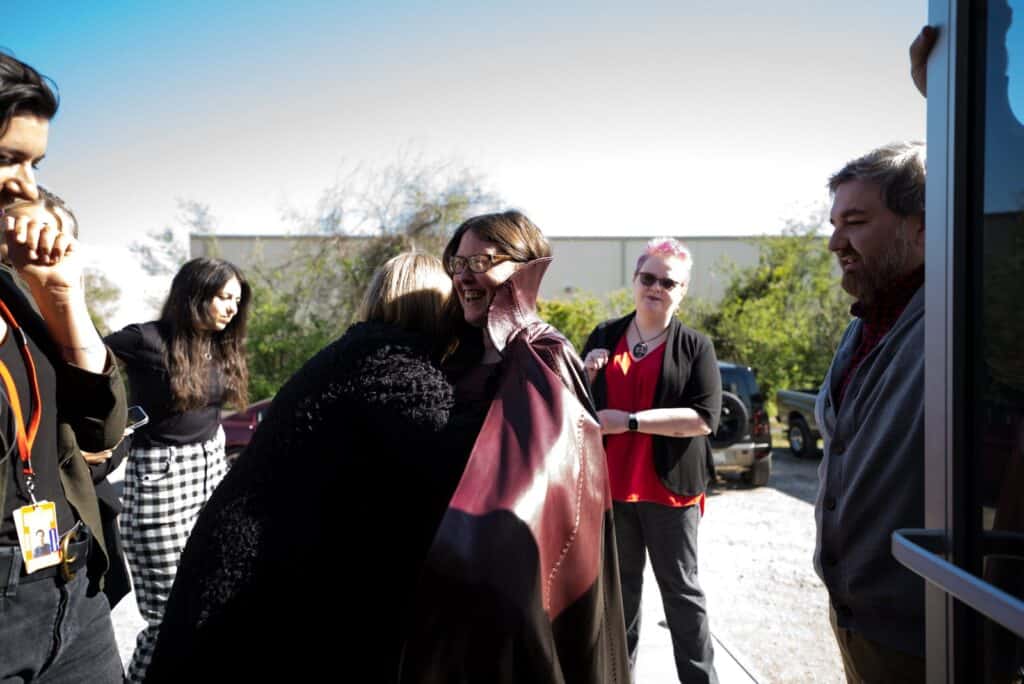
The set was beautiful and filled with a dilapidated regality that matches Dracula’s own life in the film where the vampire has seen better days. Renfield has messed up and is having to run through a rampant fire (Nicholas Hoult doing some impressive stunt work) to come to his boss’s aid. Dracula for his part (Nick Cage also does some of his own stunts) is battling it out in snarling, raging fashion while in a satin dressing the color of blood.
Watching this scene be shot, with Nick Cage getting himself ready for the fight and coming at the camera in full fanged and frothing fury was amazing. I’m not ashamed to say I may have been cheering a little too loudly and had to quiet down because it was Nick Cage as Dracula beating down wannabe Van Helsing’s on the other side of the wall. How do you not geek out?
Getting to see the costumes and the paraphernalia being worn and used by the actors, and the amount of detail that was being worked onto the screen was amazing. These are fans of the genre and the characters bringing them to life and they are doing it with a lot of love and a lot of talent. And when I say love I mean the real thing. The crew rescued a bulldog that was found wandering around near filming and they got him vet treatment, cleaned up and fed and now he’s being adopted by one of them.
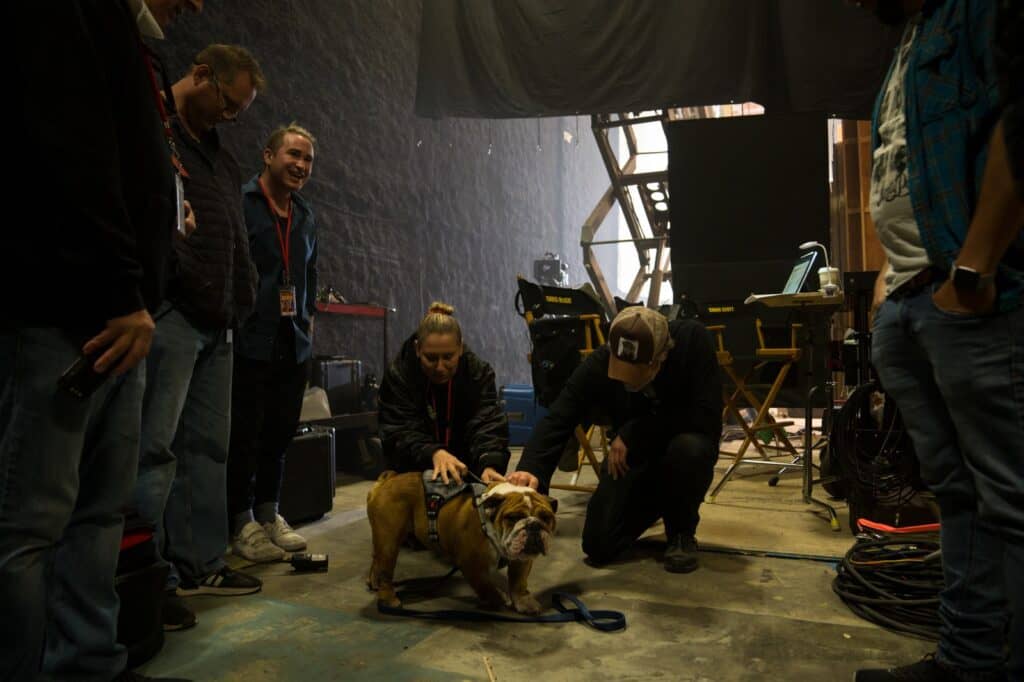
Oh and bugs…It’s Renfield after all and yes…I ate bugs with Renfield AKA Nicolas Hoult who actually did eat some real bugs. Unlike his co-star who ate a live cockroach though in Vampire’s Kiss, Hoult’s bugs are all dead and some of them are fake. I ate the fake ones (sorry I’m not that hardcore) but I did see one of our guides on set eat a rather crunchy real bug that I feel she immediately regretted. It was loud.
And oh yeah, yours truly got to wear THE CAPE (and yes, all caps is what that deserves).
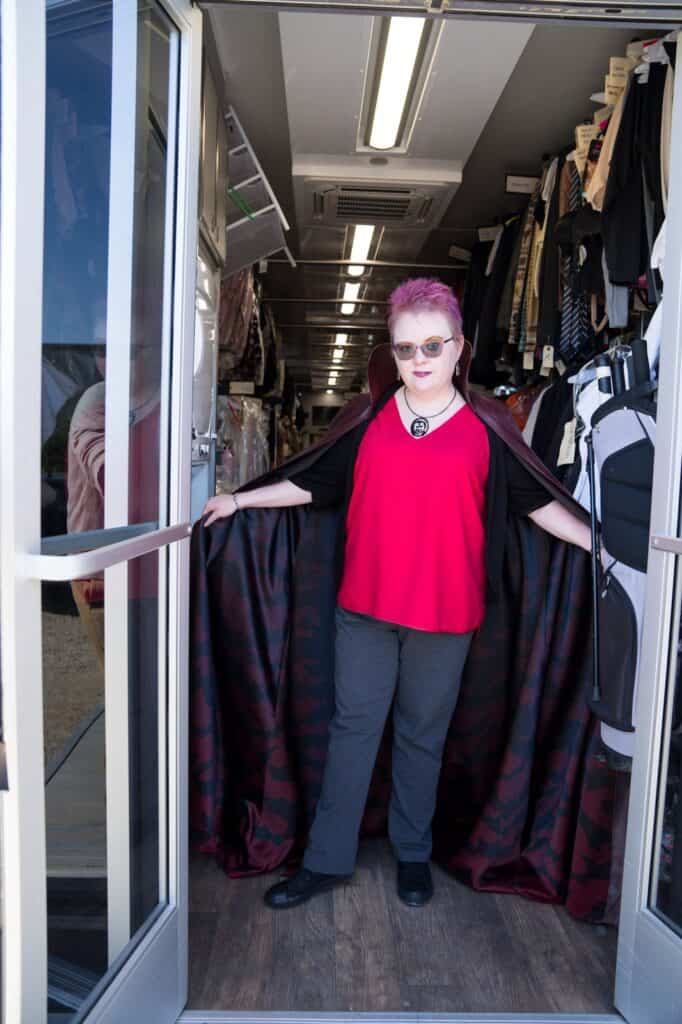
For the first part of our set-visit, we got to chat a bit production designer Alex Hammond, who gave us some insight about the film’s setting and style. One thing that’s noteworthy is that the film, is some ways, is a continuation/hommage to the classic 1931 Bela Lugosi version.
Alec Hammond: We’re actually using some direct references to the original films, and to some of the actual Universal horror movies. The original ones. So, the — so, we established for the audience those actual film — and some of those actual film images early, with this sort of, semi-unaltered. So, what — in some ways I have no choice but to — as, sort of as a designer, play off the visual world that is established in those films. We don’t go into them in depth. We definitely use some of those frames. So, even if you’d never seen the 1931 Dracula movie. If you’ve never seen Bela Lugosi, you will. And you will a little bit, in terms of — of those, sort, of cinematic images. So, everything that we do after that is a direct play off of them. One of the things I was — because we’re contemporary, obviously.
So, one of the things that I was interested in doing is maintaining the scope, the scale — those are big spaces. Like, that staircase, when he first meets Renfield is gigantic. You have a — and it sets up a couple of things. It sets up the — we’re — we need to see an en — we need to see an event. We need to see an event movie, but we also, and we — it tells who the character is. It tells us who Dracula is. It gives us a lot of information about Renfield being a real estate agent in London, coming and being sort of over — personally overwhelmed. It gives you character ideas as you’re watching the film, about who he is. And that has a direct relationship of his conflict right now — and who Dracula was. And, so one of the things that I did with those movies is more than trying to ape the design that happened, I tried to figure out what the — what was really happening with the characters and who the characters were in those, and then how the environments in those original films added to that and helped tell that story. And then, take those same things and apply them to our version, or our film, which is in the same linear — not with the same tone, but in the same linear world as those. So, when you see — think about Renfield, ‘cause I have spaces to design for Renfield for those movie that are really his — contemporary spaces they’re his. You have to, then, put yourself — okay, he’s been working with Dracula since 1931. He’s been procuring victims for him and he’s in a very different place in his life right now. But, in order to not have him just be an ass who brings people to this monster to be killed, you have to sort of get yourself into who that character is. And when you do that, you realize he’d never seen anything like that. He was being taken to, in a time where we don’t Twitter and we don’t have, you know, television, and we haven’t seen house — you know, houses of the rich and famous. He gets to go to this place that he’s never been. He’s completely overwhelmed.
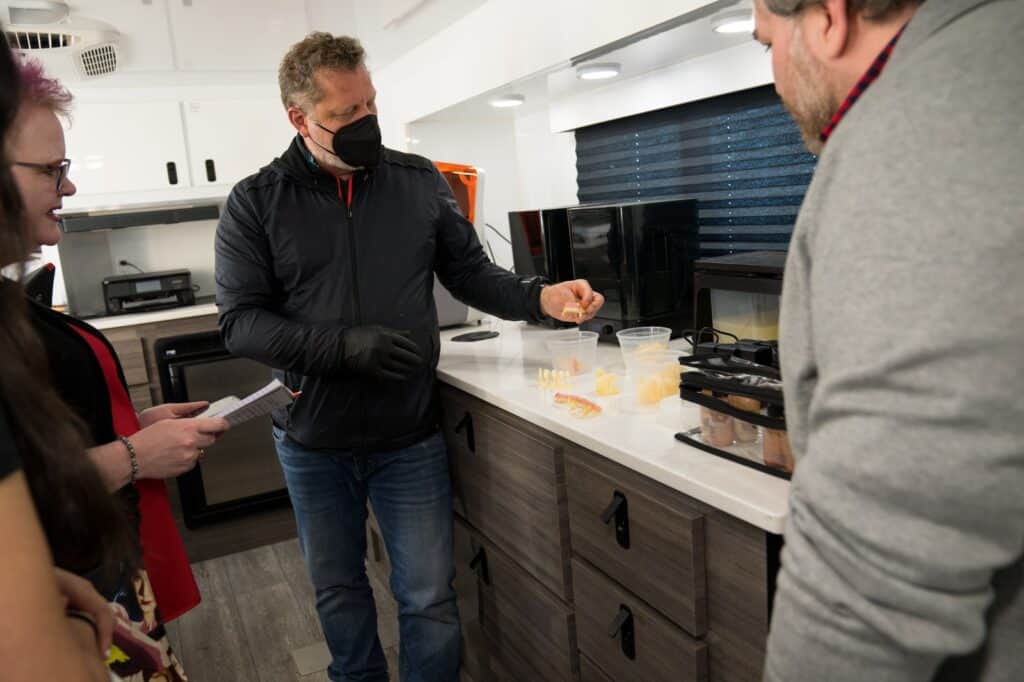
Hammond also discussed the challenge of bringing Dracula to the 21st Century, and how, in the end, Nicolas Cage was born to play the role.
One of the things that I talked to McKay about when I first read the script before knowing any of the cast or any of this is Dracula is a movie star. You know, he has to be a movie star. And, not in terms of the casting, but just who that character is because we have to feel like, oh, my God, I’d do anything to work with him. The charisma of that character has to be — because you gotta do it for a long time. You brought him a lot of people to be sucked dry and eaten in the last 99 years. And so, if it’s not somebody who has that — I mean, he’s in the most wonderful — thankfully not political, but the most wonderful narcissist you’ve ever met. And, you have — but you have to — with all those characters there has to be an end to it. So, in some ways, what I — and I think what I always try to do is, I try to build the designs from the characters out. Because nobody is coming to watch the scenery. I hope that the scenery adds to that, and they actually are — we have some wild moments in this film, in terms of what the design does, but we’re coming to watch the characters. We’re coming to watch a Dracula movie. We’re coming to watch a Renfield movie. I am a designer, and I don’t — maybe Dune, but other than Dune — other than Dune, I don’t know that I’d go to the movies to watch the scenery. Definitely went to Dune to watch the scenery.
Hammond also discussed what made the Renfield team choose New Orleans as their setting:
I like designing genre movies and I like designing theatrical genre movies because they distill down the things that we all go through on a day-to-day basis and make them so much larger than life that, in some ways, the scenery and the designs have to come up to that. So, it allows us to do, you know, I never want to live there. That’s my — I’d never want that to be my office, but damn was it fun to design. For — Ella Lobo. And, you know, you get to do things that are larger than life — excuse me — that are, sort of, over scaled, that match the — match the extreme behavior and situations of the movie. You have someone who lives on, you know, drinking — that lives from drinking somebody else’s blood. I mean, it — and you deal with that in a very straightforward way, which we also got to do. How does that work? How does it work when some — when Dracula’s reduced to needing to be nursed back to health? How would you go about, you know — you can’t breast feed the guy. How do you actually get — how do you get blood in him? And, in some ways, from sort of, these first images, which are Dracula still with some of his trappings of grandeur. Then, where he ends up, when we set him in New Orleans, is sort of, hints on the tone of this film, which is, you think of castles in Transylvania Roman — Transylvania region of Romania. I’ve been to the Vlad Dracul castle scouting for another film and they’re fantastic. But, you have that kind of bold, European grandeur and then you have the place where the movie is set, in the United States, the most — the epitome of what we would think of — the American gothic. You know? It’s — it’s the home of Lestat. It’s the home of mid — all of the vampire lore. There aren’t a lot of vampires that exist in Alburquerque. But it not a lot of historic ones. If we — if we all — if you pulled everybody in the United States and said, ‘where would a vampire live in the United States,’ they’d probably say New Orleans. And, what we get to do, in this film, and what I go to do as a designer, is go into the place where you think, great, we’re gonna go down magazine street straight and take right into the upper garden district and there’s one of those great old mansions. Got a huge, live oak in front. It has moss dropping down from everywhere, so that all falling down, it’s all boarded up, and we go directly toward it and take a left-hand turn and end up in an abandoned hospital. And, how far Dracula has fallen. But we found an abandoned hospital that looks like a castle. You know, it’s 1930s — 1932 — completely symmetrical. Feels like it could be one of those European castles. And then, he lives in the basement. And, he — it has all fallen down and how far the mighty have fallen. And, you know, there’s — I don’t know if it’s stage direction or a line, but you know Marverel’s of Ishford (ph) — vampires. Now, with Twitter and TrueCrime and, you know, in New Orleans, if you drive around here too much, you’ll probably get a speeding ticket because there’s cameras on every corner. And it’s — it would be a tough place to actually have to find victims.
Next up, we had a little impromptu group chat with writer Ryan Ridley, who explains the delicate mix of genre the filmmakers are trying to pull off with this blend of horror, action and comedy.
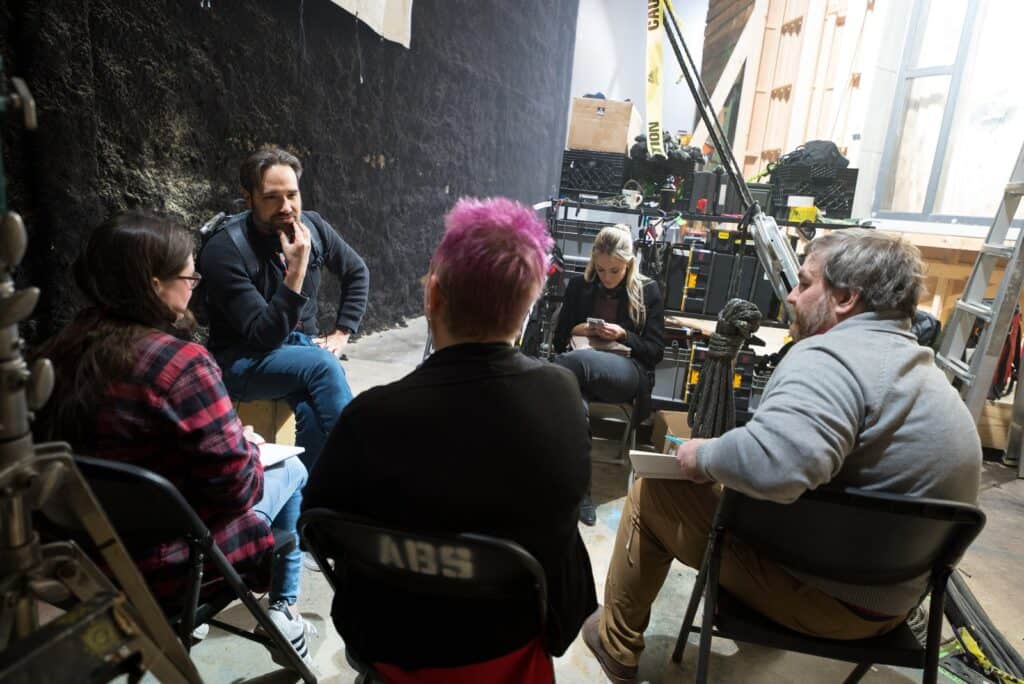
So, you’ve written a lot of animation. Writing live action versus animation — does it make it easier for you to have a more — physically having to be able to control the environment or are you more happy when it’s, like broad strokes that you can do?
Ryan Ridley: Well, I’d prefer live action, fundamentally, just ‘cause I like the live — liveness of it, like being a set, work with actors in real-time and the moments they can create. Whereas, like animation is just a long, I don’t want to use the word slog, but you know, it’s n — you’re not immersed in the process as much in the real-time process of it. But you can also do much crazier things, in theory, with animation that would be much more expensive in live action. So, it’s always a pro and con, but I prefer live action for many reasons.
Can you talk about striking the tone between, you know, we hear there’s lots of limbs flying. So, between the horror and the humor.
I think they go hand in hand, pretty — severed hand in severed hand, pretty well. You know, it’s like the darker the, you know, the darker the violence than the funnier the comedy will be, often times, you know. So, and that’s certainly my, like inspiration is like Sam Ramey and early Peter Jackson and Return of the Living Dead. So, that’s just, like in my, you know, creative DNA. So, it was easy, in theory.
So, when you were creating the relationship between Dracula and Renfield, in the original film, their relationship didn’t end great. They — he was murdered. So, can you talk about how that works in this film and writing for Nick and Nick.
Yeah, well, I guess, so, now I’m feeling busted. Renfield dies in the original film?
Yes.
Well, let’s pretend that was — you know what, what we’ll learn is that through supernatural abilities, he’s never really dead, or at least he can come back from — he’s really wounded. So, you know, the idea is, like what if, after that first movie, throughout the next x-amount of decades, they continue to have adventures together and continued the cycle of what we’re going to see in this, you know, scene that’s being shot today. Like, the ultimate, you know, the destruction of Dracula once his enemies — vampire enemies find him, and then Renfield’s always trying to — always picking up the pieces. And so, it’s like the relationship is like, you know, kind of just like being the personal assistant to, like the most self-destructive, like rock star, movie star, whatever, in history and so, it’s sort of, like intertwining that classic Dracula familiar — am I allowed to still talk — relationship with the classic, like, modern contemporary assistant-boss relationship. You know? So. Yeah.
The latest trailer for Renfield comes out tomorrow! Read our interview with Nicolas Cage here. More to come later this week from director Chris McKay and Awkwafina!
Originally published at https://www.joblo.com/renfield-set-visit/




